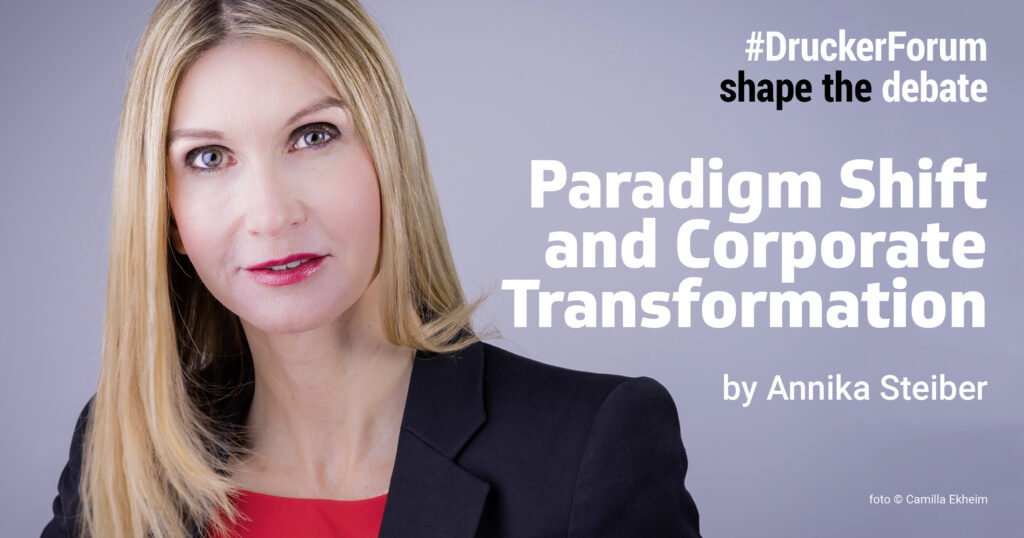
Any management model aims to maximize three things: Value for the company, Loyalty and productivity among Employees, and Knowledge about, and Solutions for, Users’ aspirations and true needs. However, the traditional model, based on bureaucracy, a clear distance between the company and its users, and subordinary-superiority between employees, cannot maximize all three objectives at the same time.
No less than a paradigm shift is needed.
Peter Drucker describes in ‘Management Challenges for the 21st Century’, a paradigm as a set of basic assumptions about the reality. These assumptions are usually held subconsciously by business leaders and scholars, and despite their importance, they are rarely analyzed and challenged. However, with the development of the Internet and new technologies, it is today impossible to ignore the need for changing the underlying assumptions behind managing the firm.
According to Chairman Emeritus Zhang Ruimin from Haier, three new management assumptions are needed:
- Turn employees into autonomous entrepreneurs
- Allow autonomous entrepreneurs to form smaller businesses (micro enterprises)
- Encourage micro enterprises to form micro communities (business ecosystems) that share a common goal to meet unmet users’ needs
Haier’s own transformation to implement the new management paradigm is a result of almost two decades of learning and development work through constant experimentations. However, by now being able to show case a tangible solution to the new paradigm, other company leaders can transform their own businesses much more rapidly.
Two of these companies are the USA based GE Appliances and the Portugal based Fujitsu Europe.
The Case of GE Appliances
Before the sale to Haier, GEA had experienced stagnant growth and loss of market share by adhering to the parent company’s management paradigm. Five years after the acquisition, the company had become the fastest growing appliance company in the US and has won recognition as the go-to smarthome appliance company for four consecutive years.
The former VP of Technology, Kevin Nolan had felt frustrated with how the company was managed before the acquisition, and after becoming CEO in 2017 he had the mandate to transform the company. The transformation was guided by Haier’s new management model. An executive council with a team of three was created and one hierarchy layer was immediately taken away. The executive team members then divided the transformation work among them and met weekly to take the ‘pulse’ on the transformation work. The transformation was done in two phases, the ‘micro enterprise phase’ (2016-2020) and the ‘ecosystem phase’ (2021+).
In the first phase GEA’s executive council communicated the new goal of becoming # 1 in North America. Further, four micro enterprises (MEs) were established, and decision power was delegated. To further align the organization to users’ needs, commercial and operational functions such as marketing, sales, and manufacturing were transformed into serving platforms. The CEO encouraged the transformation by sending a weekly video to all employees. As a result of the success of phase I, the second ‘ecosystem’ phase has now been initiated.
The general approach for each phase could be described as:
Step 1: intensive internal communication in which pillars of the Haier model are discussed and interpretated.
Step 2: experimentation and constant feedback loops to refine and improve the new way of working.
Step 3: implement and scale up the new way of working
Step 4: continuously maintain change by using extensive communication from the CEO and other senior leaders
Step 5: identify and prepare the next step needed in the transformation of the business
The Fujitsu Europe Case
Fujitsu is one of the world’s largest IT service providers. For the Vice President of Western Europe, Joao Domingos, the insight about declining and shrinking traditional businesses combined with exponential business opportunities using new technology, acted as the wake-up call. The old way of working was not going to work in the future. In 2019, after listening to Zhang Ruimin, he decided to use the Haier model as a basis for his transformation.
He presented Haier’s concept of MEs to his direct managers and asked them to support the implementation of a pilot in the organization. As the next step, his team spent three months planning the deployment of the pilot and decided: the business focus of the new MEs, who should/want to work in them; and their mandate. In parallel, the plan was communicated to the organization, and feedback and concerns were collected. In 2020, they implemented 14 MEs at the same time as decentralizing decision power. All in all, 160 people were allocated to the new businesses. Today, the organization has 20 MEs. To support them a small team was created. The success of each ME is measured using metrics. The data is collected automatically, which is part of the new culture to coach rather than review new businesses. To keep the MEs on track, Fujitsu Europe has regular feedback sessions to coach and support them and the focus is on the learning.
The result is positive. The Net Promoter Score and the employee engagement score improved by 10 points. Further, several of the microenterprises have double to triple digit growth rate. The next step is to continue to move more parts of the organizations into this model and build ecosystems of ME’s.
In conclusion, the new management paradigm is here to stay. The paradigm shift requires new assumptions and these are already practiced by some leading companies. Others can effectively transform IF they a) are aware of the new set of assumptions and b) are aware of solutions on how to implement them. Further, a successful transformation requires local adjustments of the new management model.
About the author:
Dr. Annika Steiber, author of the Springer book Leadership for the Digital Age

